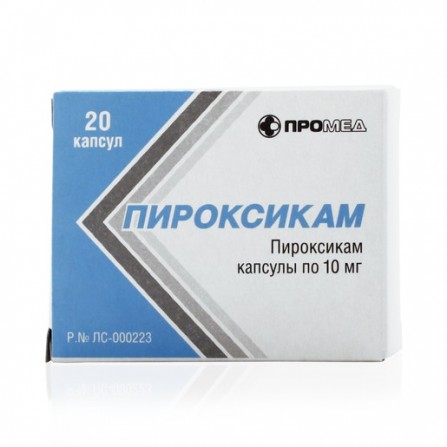Piroxicam capsules 10 mg 20 pcs
Condition: New product
1000 Items
Rating:
Be the first to write a review!

More info
Active ingredients
Piroxicam
Composition
1 capsule contains: piroxicam 10 mg. Excipients: powdered cellulose, sodium carboxymethyl starch (sodium starch glycolate), potato starch, sodium lauryl sulfate, magnesium stearate, gelatin, titanium dioxide or gelatin, titanium dioxide, dye blue patented.
Pharmacological effect
Piroxicam is a nonsteroidal anti-inflammatory and antirheumatic agent. It has anti-inflammatory, analgesic and antipyretic effects. It is used for rheumatic diseases, pain syndrome and articular syndrome.
Indications
Inflammatory and degenerative diseases of the musculoskeletal system: rheumatoid and gouty arthritis, rheumatism, ankylosing spondylitis (Bechterew's disease), osteoarthritis. Pain syndrome: sciatica, tendovaginitis, bursitis, arthralgia, neuralgia, myalgia, sciatica, post-traumatic and postoperative pain syndrome, accompanied by inflammation, algomenorrhea. Feverish syndrome with colds and infectious diseases.
Contraindications
Hypersensitivity, erosive and ulcerative lesions of the gastrointestinal tract (in the acute stage), "aspirin" asthma, hepatic and / or renal insufficiency of bleeding disorders (including hemophilia, prolonged bleeding time, bleeding tendency, hemorrhagic diathesis) 14 years), age over 65 years, pregnancy, lactation for rectal administration - proctitis, anorectal bleeding.
Use during pregnancy and lactation
Patients with impaired gastrointestinal function, after extensive surgical interventions in old age, patients with bronchial asthma and chronic bronchospastic diseases in history, it is necessary to monitor the cellular composition of blood, kidney and liver function. In women, a decrease in the contraceptive effect of IUD is possible due to the influence of piroxicam on the tone of the myometrium. Recommendations for use in children are not currently developed. During treatment should be excluded the use of ethanol. Do not apply on damaged skin. Avoid contact with eyes or mucous membranes. During the period of treatment, care must be taken when driving vehicles and occupying others.potentially hazardous activities that require increased concentration of attention and quickness of psychomotor reactions.
Dosage and administration
Inside In rheumatoid arthritis, osteoarthritis and ankylosing spondylitis - 10-30 mg / day in 1 reception, for a long time. In acute diseases of skeletal muscles - 40 mg / day for one or several doses for 2 days, for the next 7-10 days - 20 mg / day. When treating a gout attack, the initial dose is 40 mg, once in the first 2 days, then for 4-6 days - 40 mg 1 time or 20 mg 2 times a day. With algodismenorrhea, treatment should begin when the first symptoms appear in the initial dose of 40 mg / day in 1 or several doses for 2 days. In the next 1-3 days - 20 mg in 1 reception. When juvenile rheumatoid arthritis is prescribed 1 time per day: children older than 14 years old weighing more than 46 kg - 20 mg / day.
Side effects
Displaces drugs from the association with blood proteins, reduces the effectiveness of antihypertensive drugs (due to the delay of Na +, K + and water in the body), increases the concentration of phenytoin and Li + drugs. Increases the risk of hyperkalemia when combined with potassium-sparing diuretics and K + donators, the risk of ulceration of the gastrointestinal mucosa with GCS. ASA reduces the concentration of piroxicam in the serum. In combination with anticoagulants, it reduces the ability of platelets to aggregate (risk of bleeding). Myelotoxic drugs increase the hematotoxicity of the drug.
Interaction with other drugs
Precautionary measures
special instructions
On the part of the digestive system: pain and discomfort in the abdomen (including epigastria), flatulence, nausea, constipation, diarrhea, peptic ulcer, bleeding from the gastrointestinal tract, anorexia, vomiting, dyspepsia, stomatitis, glossitis, pancreatitis, hepatitis. On the part of the central nervous system: dizziness, headache, increased appetite, sedation, drowsiness, amnesia, anxiety, depression, anxiety, hallucinations, insomnia, unusual dreams, nervousness, paresthesia, personality change, tremor, akathisia. On the part of the senses: tinnitus, vertigo, deafness, blurred vision, irritation or swelling of the eyes. Laboratory indicators: increased activity of “liver” enzymes (LDH, ALP, transaminases), increased concentration of urea nitrogen, hypercreatininemia, decreased Hb and hematocrit, hypoproteinemia, thrombocytopenia, leukopenia, anemia (includingaplastic and hemolytic), hyperglycemia, hypoglycemia, detection of antinuclear antibodies. On the part of the cardiovascular system: an increase in blood pressure, tachycardia, a sensation of heartbeat, "tides" of blood to the skin. From the skin: rash (including petechial), purpura, including thrombocytopenic, ecchymosis, pruritus, onycholysis, alopecia, photosensitivity, exfoliative dermatitis, erythema multiforme, Lyell's syndrome, Stevens-Johnson syndrome, vesicular-bullous reactions. On the part of the urogenital system: edema, dysuria, frequent urination, hematuria, oliguria, menorrhagia. On the part of the respiratory system: nosebleeds, shortness of breath. Other: pain in the chest, thirst, chills, excessive sweating, increased or decreased body weight.




